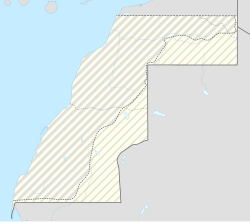Es Semara
|
Smara السمارة |
|
|---|---|
 |
|
| Location in Western Sahara | |
| Coordinates: 26°44′22″N 11°40′13″W / 26.73944°N 11.67028°W | |
| Country | Western Sahara |
| Claimed by |
|
| Controlled by | Morocco |
| Founded | 1869 |
| Population (2014) | |
| • Total | 57,035 |
Smara (Arabic: السمارة as-Samāra; also Romanized Semara) is a city in the Moroccan-controlled part of Western Sahara, with a population estimated at 57,035 (2014). It is served by Smara Airport and Smara bus station.
The largest city in its province, Smara was founded in the Saguia el-Hamra as an oasis for travellers in 1869. It is the only major city in Western Sahara that was not founded by the Spanish. In the center of the city the remains of a stone fortress can be found, the Zawiy Maalainin, which enclosed a mosque. The Maalainin lived there from 1830 until 1912. It was made a capital and religious center in 1902 by shaykh Ma al-'Aynayn, in what was then Spanish Sahara. The location of the city was intended to ensure its becoming a caravan trade hub in the sparsely populated Sahara desert. The enlargement of Smara was carried out by local Sahrawis as well as craftsmen sent by the sultan Hassan I. In 1902, shaykh Ma al-'Aynayn moved to Smara and declared it his holy capital. Among other things, he created an important Islamic library, and the town became a center of religious learning.
In 1904 the shaykh declared himself an imam and called for holy war (jihad) against French colonialism, which was increasingly pressing into the Sahara at this time. During the campaign against Ma al-'Aynayn, Smara was sacked almost completely in 1913 by the French Army, and its library destroyed. The town was then handed over to the Spanish. In 1934 the town was once again destroyed after Sahrawi rebellions against the Spanish occupation.
Reaching Ma el Ainain's mysterious Smara was the goal of the brothers Vieuchange, early 20th-century French writers and romantics. Michel Vieuchange's painful journey through the rebel-held Sahrawi lands in 1930 disguised as a Berber tribeswoman, eventually reaching Smara on 1 November 1930, and the illness that lead to his death on the return, is documented in his journals. Comprising seven notebooks and more than 200 photographs, the account was published posthumously in 1932 as Smara: The Forbidden City (1932) by his brother Jean and became a bestseller.
...
Wikipedia

